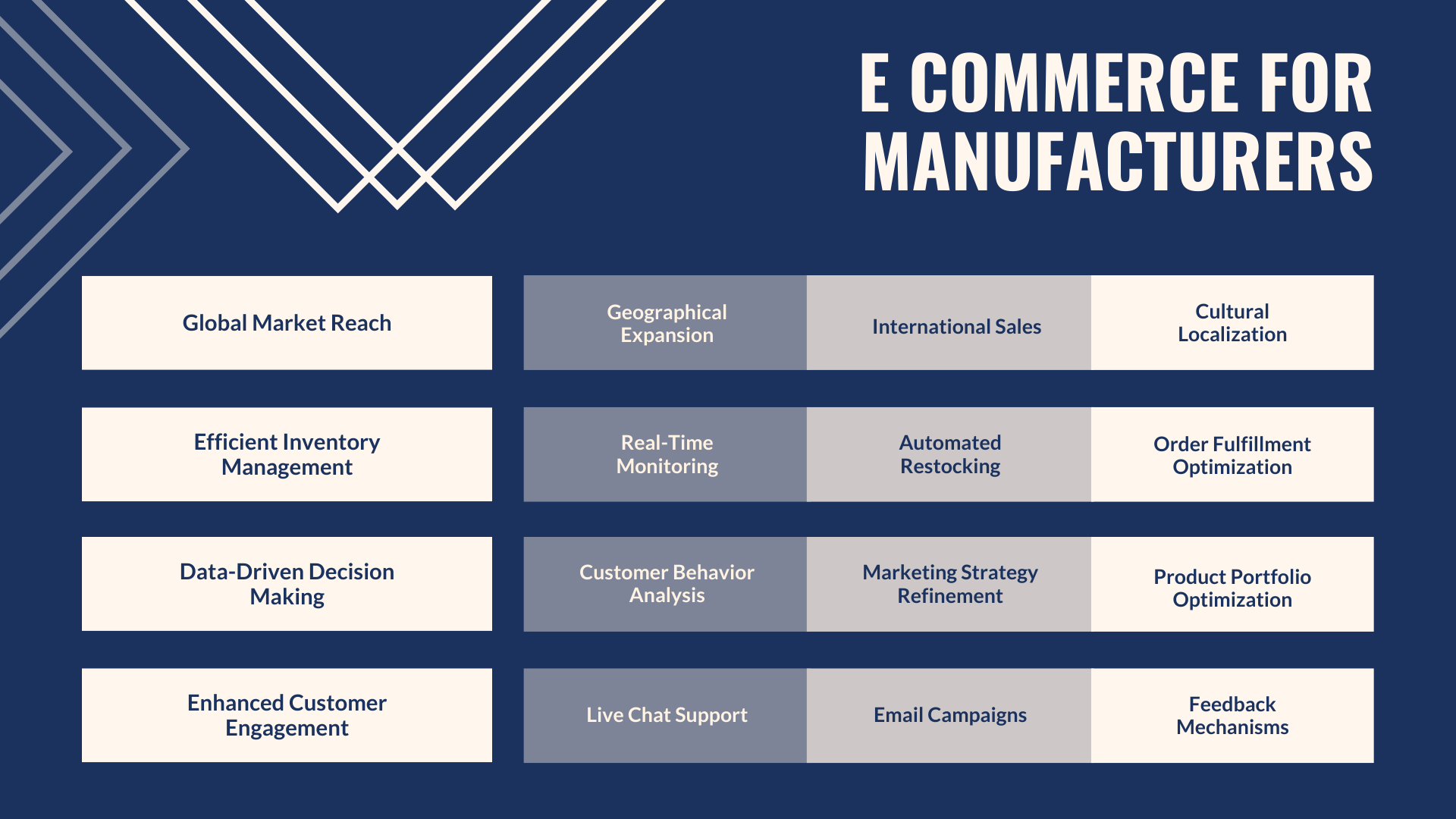- Introduction
- Significance: SEO Empowered Ecommerce for manufacturers
- Why Shopify for Small Manufacturers?
- Unlock Your Path to Success – Getting Started with Shopify for Free
- Customizing Your Store
- Adding Products
- Setting Up Payment and Shipping
- Configuring Taxes
- Launching Your Store
- Marketing Your Brand
- Optimizing for SEO
- Creating a Blog within Shopify
- Analyzing Store Performance
- Adapting and Improving
- Conclusion
Introduction
In the dynamic landscape of commerce, small manufacturers are rewriting the narrative of success with the click of a button. As we dive into the digital era, the intersection of craftsmanship and technology beckons, and Shopify emerges as the guiding light for those wielding the tools of creation. This represents an approach toward forward integration.
Join me on a journey through the virtual aisles of Ecommerce for manufacturers. In this blog, we’ll unravel the secrets that transform humble workshops into global marketplaces, exploring the symbiosis between artisanal expertise and e-commerce finesse. It’s time to embrace the power of pixels, where every byte is a brushstroke painting on the canvas of manufacturing triumph. Welcome to the digital revolution, where the future is handcrafted and the success story is yours to script.
Significance: SEO Empowered Ecommerce for manufacturers
In a world driven by screens, the importance of a digital presence for small manufacturers transcends mere visibility—it’s the heartbeat of a thriving business. Your workshop might echo with the hum of machinery, but in the digital realm, your creations resonate with a global audience.

Picture this: a digital storefront on Shopify becomes your 24/7 showroom, inviting customers from every corner of the globe to admire, engage, and purchase. Your online presence is the handshake that introduces your craft to the world, creating connections that transcend geographical boundaries.
A well-crafted digital identity doesn’t just showcase products; it narrates a story, weaving the threads of your craftsmanship into a compelling narrative. It’s more than a website; it’s an invitation to join the journey of creation.
In the realm of small manufacturing, a robust online presence isn’t a luxury—it’s the catapult that propels you into the spotlight. It’s not just pixels on a screen; it’s the bridge between your workshop and the world. In a digital age, your success story begins with a click.
Why Shopify for Small Manufacturers?
Shopify isn’t just a platform; it’s the warp and weft weaving success for small manufacturers to create Ecommerce for manufacturers. Imagine a digital workshop where every tool is intuitive, every process streamlined, and your creations take center stage. Shopify does just that—it transforms the complexities of e-commerce into a seamless dance.
Designed with simplicity in mind, Shopify becomes the silent partner in your craftsmanship journey. From inventory management to secure transactions, it’s the backstage crew ensuring your spotlight moment.
Flexibility is its forte; whether you’re a bespoke jeweler or a custom furniture maker, Shopify molds to your needs. No coding jargon, just an easy-to-navigate canvas to showcase your artistry.
Moreover, Shopify is the gateway to a global market. It’s not just a platform; it’s the digital passport for small manufacturers, facilitating connections beyond borders.
In the realm of small-scale creation, Shopify isn’t just a choice; it’s the catalyst propelling your craft from workshop whispers to a global symphony of success.
Unlock Your Path to Success – Getting Started with Shopify for Free
Embarking on your Shopify journey is a breeze, ushering your small manufacturing business into the digital spotlight. Visit Shopify’s user-friendly site at www.shopify.com and hit “Get Started.” Enter your email, set a password, and define your store’s name. Next, Shopify guides you to customize your storefront—pick a template, add your products, and infuse your brand’s personality.

Once done, click “Launch,” and voila, your digital workshop is open for business. Explore Shopify’s dashboard for order tracking, inventory management, and more. Don’t forget to personalize your domain; it’s your digital storefront’s address on the web.
With Shopify, the transition from workshop to online success is not just seamless, it’s empowering.
Customizing Your Store
Customizing your Shopify store is crucial to set up Ecommerce for manufacturers to establish a unique brand identity and enhance user experience. Begin by selecting a visually appealing theme that aligns with your products and brand image. Use Shopify’s intuitive drag-and-drop editor to personalize the layout, colors, and fonts, ensuring consistency with your brand.
Incorporate high-quality images of your products and create compelling product descriptions. Leverage Shopify’s customization options to add a logo, and favicon, and customize the navigation menu. Implement user-friendly navigation and organize products into categories for easy exploration.

Utilize apps and plugins to enhance functionality, such as inventory management and order tracking. Regularly update and optimize your store to keep it fresh and aligned with your evolving business needs.
Adding Products
In the pivotal step of adding products to your Shopify store, begin by navigating to the ‘Products’ section in your dashboard. Click ‘Add product’ to create a comprehensive listing for each item. Input essential details such as product name, description, price, and high-quality images. Utilize Shopify’s user-friendly interface to organize products into relevant categories, facilitating seamless navigation for customers.
Leverage the platform’s inventory tracking features to manage stock levels efficiently. Implement product variants for different options like size or color. Additionally, optimize product pages with compelling meta titles and descriptions to enhance search engine visibility.

Ensure a seamless shopping experience by setting up secure payment gateways and configuring shipping options. Regularly update and refine your product listings to stay relevant and appealing to your target audience.
Setting Up Payment and Shipping
Setting Up Payment and Shipping” on Shopify for small manufacturers, begin by integrating secure payment gateways like PayPal or Stripe to facilitate seamless transactions. Configure shipping settings by defining shipping zones, rates, and carriers based on your product dimensions and destination regions.

Offer transparent shipping information to customers and consider providing multiple shipping options to accommodate diverse preferences. Additionally, leverage Shopify’s automated shipping calculations to streamline the process. Ensure that your payment and shipping policies align with your business model and customer expectations, fostering trust and satisfaction.
Regularly review and update these settings to adapt to changing business needs and enhance the overall shopping experience for your customers.
Configuring Taxes
In your Ecommerce for manufacturers, configuring taxes for small manufacturers is crucial for compliance. Begin by navigating to the Settings menu and selecting Taxes. Enable automatic tax calculation based on your business location. Specify product tax codes and ensure accurate rates for different regions. If selling internationally, consider using Shopify’s integrated tax tools or third-party apps to streamline cross-border tax compliance.

Regularly update tax settings to align with evolving regulations. Thoroughly test the setup to guarantee seamless and accurate tax calculations at checkout, fostering a transparent and hassle-free shopping experience for customers. Regularly review tax policies to stay abreast of changes, ensuring continued compliance for your small manufacturing business.
Launching Your Store
Launching your Shopify store is the pivotal moment in establishing a Ecommerce for manufacturers. Begin by selecting a compelling theme that aligns with your brand ethos and emphasizes user-friendliness. Integrate essential apps for inventory management, order processing, and analytics to streamline operations.
Optimize product pages with high-quality images, detailed descriptions, and SEO-rich content to enhance visibility. Implement a secure payment gateway to instill customer trust. Leverage Shopify’s marketing tools to drive traffic, and ensure your Ecommerce for manufacturers is responsive across devices. Finally, conduct thorough testing before unveiling your online storefront, marking the inception of your manufacturing venture into the digital realm.
Marketing Your Brand
Effectively market your brand on Shopify by crafting a compelling story that highlights your unique selling points. Create engaging product descriptions, high-quality images, and a user-friendly website. Leverage social media channels, such as Instagram and Facebook, to showcase your products and connect with your target audience. Implement email marketing campaigns to nurture leads and retain customers.
Utilize Shopify’s built-in SEO tools to optimize your online store for search engines. Collaborate with influencers and consider running promotions to boost visibility. Consistent branding and customer engagement will help establish your Ecommerce for manufacturers on Shopify and drive sustained success.
Optimizing for SEO
Optimizing your Shopify store for SEO is essential, especially for a Ecommerce for manufacturers. Strategically integrate this keyword into product titles, descriptions, and meta tags to enhance search engine visibility. Craft user-friendly URLs and ensure mobile responsiveness for a seamless browsing experience.
Generate a sitemap to aid search engines in indexing your content, and use descriptive alt text for images. Encourage customer reviews and provide informative, concise content to boost your online presence.
Creating a Blog within Shopify
To publish a blog on Shopify for small manufacturers, navigate to the admin dashboard, select “Online Store,” and click “Blog.” Choose “Manage Blogs” to add a new one. Click “Create Blog” and input relevant details like title and description. Customize the layout and design settings to align with your brand. Utilize the user-friendly editor to craft engaging and informative posts.

Optimize for SEO by incorporating keywords and meta descriptions. Finally, preview and publish your blog to enhance brand visibility and engage your target audience effectively within the Shopify platform. Regularly update the blog with industry insights, product highlights, and company updates for sustained customer interest.
Analyzing Store Performance
Analyzing store performance on Shopify is crucial for Ecommerce for manufacturers seeking success. Utilize Shopify’s analytics tools to assess key metrics such as traffic sources, conversion rates, and product popularity. Dive into data on customer behavior, including page views and time spent on site, to identify trends and optimize content. Evaluate sales performance, track inventory turnover, and monitor customer retention rates.
Leverage this information to refine marketing strategies, enhance product offerings, and streamline operations. Regularly review reports and analytics to stay informed, adapt to market changes, and ensure your Shopify store evolves in alignment with your manufacturing goals, ultimately fostering sustainable growth and customer satisfaction.
Adapting and Improving
Analyzing store performance on Shopify is crucial for small manufacturers to optimize their online presence and drive sales. Begin by leveraging Shopify’s built-in analytics tools to track key metrics such as website traffic, conversion rates, and popular products. Utilize the ‘Reports’ section to gain insights into customer behavior, identifying peak traffic times and preferred product categories. Continuous improvement is key to success.
Additionally, explore the ‘Sales Channels’ report to assess the effectiveness of different sales channels and allocate resources accordingly. Pay attention to customer demographics and purchasing patterns through the ‘Customer’ report to tailor marketing strategies. Utilize Google Analytics integration for more comprehensive data analysis.
Regularly review performance metrics to identify trends and areas for improvement. Assess the impact of marketing campaigns and promotions on sales, adjusting strategies based on data-driven insights. This continuous analysis empowers small manufacturers on Shopify to make informed decisions, refine their approach, and ultimately enhance their online store’s success.
Conclusion
In conclusion, setting up a Shopify store for small manufacturers requires a strategic approach and ongoing dedication. From establishing a user-friendly storefront to optimizing product listings and streamlining checkout processes, every step contributes to a seamless online shopping experience.
Leveraging Shopify’s robust analytics tools is paramount, allowing manufacturers to gain valuable insights into customer behavior and tailor their strategies accordingly. As the e-commerce landscape evolves, the key lies in adaptability and data-driven decision-making in your Ecommerce for manufacturers.
By consistently analyzing store performance, refining marketing tactics, and staying attuned to customer preferences, small manufacturers can not only establish a successful Shopify presence but also thrive in the competitive digital marketplace.
The journey doesn’t end with setup; it’s an ongoing commitment to excellence and customer satisfaction that paves the way for sustained success.









